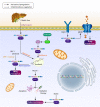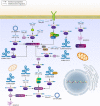Deciphering STAT3 signaling potential in hepatocellular carcinoma: tumorigenesis, treatment resistance, and pharmacological significance
- PMID: 37085753
- PMCID: PMC10122325
- DOI: 10.1186/s11658-023-00438-9
Deciphering STAT3 signaling potential in hepatocellular carcinoma: tumorigenesis, treatment resistance, and pharmacological significance
Abstract
Hepatocellular carcinoma (HCC) is considered one of the greatest challenges to human life and is the most common form of liver cancer. Treatment of HCC depends on chemotherapy, radiotherapy, surgery, and immunotherapy, all of which have their own drawbacks, and patients may develop resistance to these therapies due to the aggressive behavior of HCC cells. New and effective therapies for HCC can be developed by targeting molecular signaling pathways. The expression of signal transducer and activator of transcription 3 (STAT3) in human cancer cells changes, and during cancer progression, the expression tends to increase. After induction of STAT3 signaling by growth factors and cytokines, STAT3 is phosphorylated and translocated to the nucleus to regulate cancer progression. The concept of the current review revolves around the expression and phosphorylation status of STAT3 in HCC, and studies show that the expression of STAT3 is high during the progression of HCC. This review addresses the function of STAT3 as an oncogenic factor in HCC, as STAT3 is able to prevent apoptosis and thus promote the progression of HCC. Moreover, STAT3 regulates both survival- and death-inducing autophagy in HCC and promotes cancer metastasis by inducing the epithelial-mesenchymal transition (EMT). In addition, upregulation of STAT3 is associated with the occurrence of chemoresistance and radioresistance in HCC. Specifically, non-protein-coding transcripts regulate STAT3 signaling in HCC, and their inhibition by antitumor agents may affect tumor progression. In this review, all these topics are discussed in detail to provide further insight into the role of STAT3 in tumorigenesis, treatment resistance, and pharmacological regulation of HCC.
Keywords: Hepatocellular carcinoma; Liver cancer; Molecular signaling; Noncoding transcripts; STAT3.
© 2023. The Author(s).
Conflict of interest statement
The authors declare that they have no competing interests.
Figures






References
Publication types
MeSH terms
Substances
Grants and funding
LinkOut - more resources
Full Text Sources
Medical
Miscellaneous

